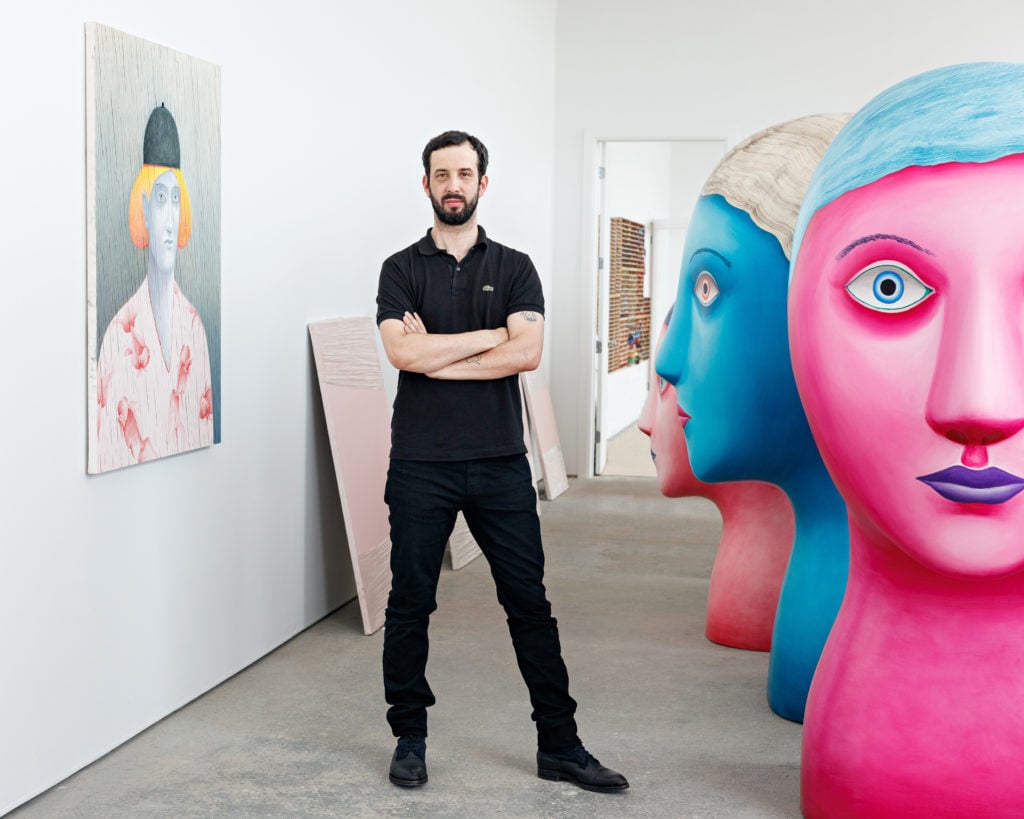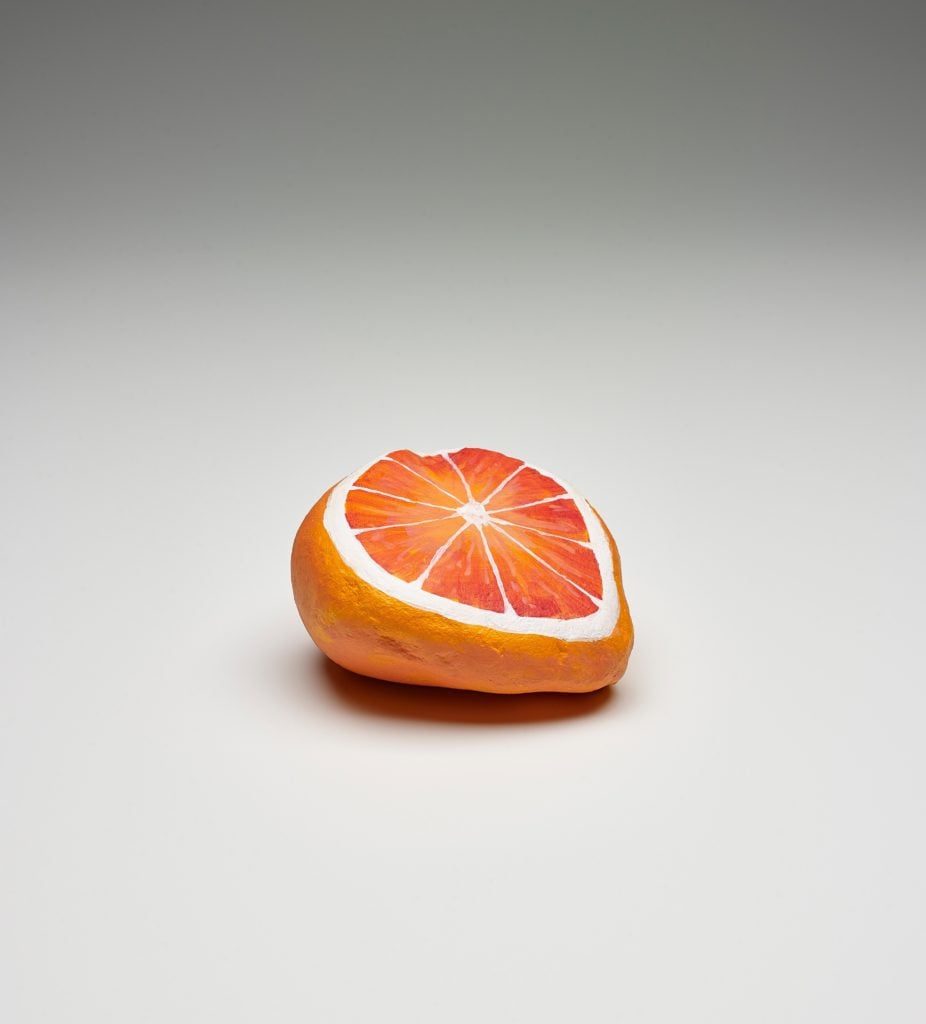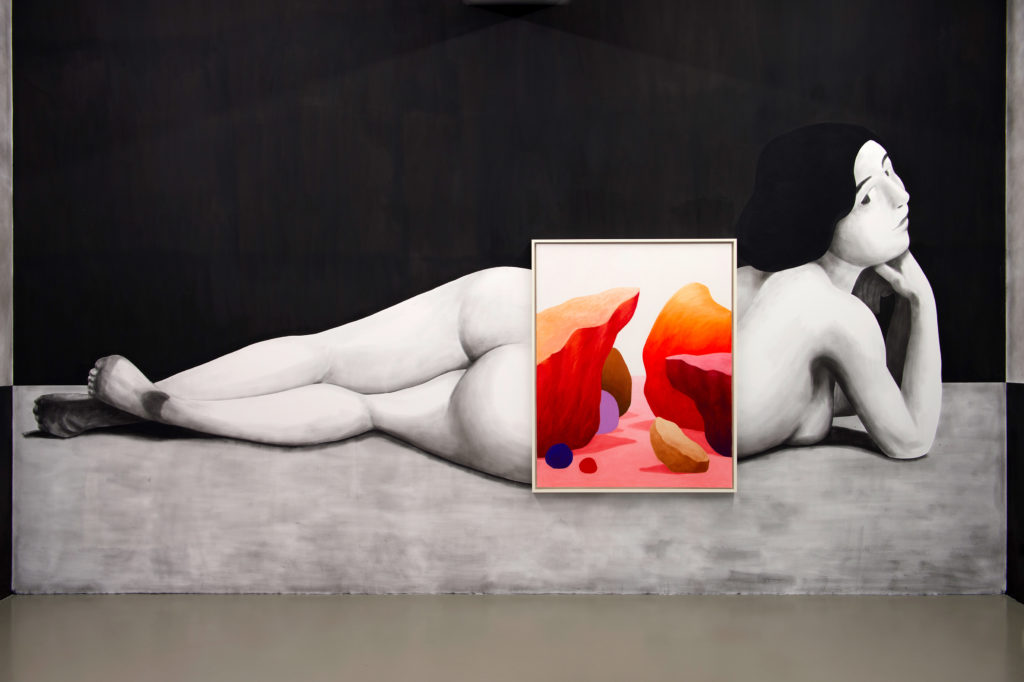Analysis
The Art Market Is Having a Party About Nicolas Party. Here’s How the Playful Young Art Star Got So Hot, So Fast
What's driving the flurry of interest in the young artist's work?

What's driving the flurry of interest in the young artist's work?

Naomi Rea

Where were you when you first heard that Nicolas Party was the Next Big Thing? I was at an art fair in Brussels two years ago, where the young artist had transformed the booth of veteran Brussels dealer Xavier Hufkens into a kind of surrealist chapel. Fairgoers clamored to get a glimpse of the Swiss artist’s dreamy landscapes through the installation’s arched windows.
That scene—droves of people jostling and craning their necks to get in on the action—turns out to be an apt metaphor for Party’s place in the art world right now. After a spate of high-priced auction sales this spring, mega-gallery Hauser & Wirth announced in June that it would represent the 39-year-old artist, making him one of the youngest names on its robust roster.
Now, Party’s market finds itself in that short-lived sweet spot for speculators and eagle-eyed collectors: after the artist has become a safe bet, but before his prices jump following a mega-gallery debut. Party won’t have his first show with Hauser & Wirth until 2020, and established collectors and new market entrants alike are scrambling to get their hands on the work before then.
Even in the dog days of August, when most of the art world is in Martha’s Vineyard or the South of France, inquiries are pinging from inbox to inbox as buyers vie to get an invitation to this particular Party.
In a relatively unusual move, the Brussels- and New York-based artist has maintained his network of smaller international galleries alongside Hauser & Wirth. Party continues to be represented by Hufkens, Kaufmann Repetto in Milan, Modern Institute in Glasgow, Galerie Gregor Staiger in Zurich, and Karma in New York.
Together, they have created a strong foundation for the artist, facilitating impressive institutional exhibitions at public spaces like the Hirshhorn Museum and Sculpture Garden in Washington, DC, and private museums including the Marciano Art Foundation in Los Angeles and M WOODS in Beijing.
The market buzz around Party has reached new heights over the past year as his work gained traction on the secondary market. In September, Sunset (2018) sold for $330,000, eclipsing a high estimate of $80,000, at a Phillips charity auction. Just eight months later, the auction house sold a comparable landscape from 2015 for nearly twice that—$608,000—setting Party’s current record.
All told, the artist’s work has come to auction 14 times, all in the past two years. Eight of these sales happened in the first six months of 2019, generating a total of $1.6 million.

Nicolas Party, Blakam’s Stone (Orange) (2016). Courtesy Phillips. Estimate: $12,000 – 18,000.
Now that the floodgates have opened, we can expect much more in the coming season. Phillips has a selection of playful sculptures—rocks painted to look like fruit called “Blakam’s Stones”—in its current selling exhibition, and eight more works will hit the block in September, including an early watercolor landscape and a pastel portrait. (Works in pastel—Party’s signature medium—are his most sought-after.)
“We’re seeing pretty strong interest from consignors wanting to take advantage of the interest, and I’ve also had a number of clients reaching out with works that they would rather offer privately,” the head of Phillips’s New Now sale, Sam Mansour, tells artnet News. “Some have even turned down offers because they felt like there is even more room for this market to develop.”
What is driving the flurry of interest? Mansour attributes it to the fact that taste has turned away from process-based abstraction (aka Zombie Formalism) toward more dreamy and surrealist figuration. (Other examples of artists working with a similar type of playful figuration who are gathering market heat are Julie Curtiss, Jamian Juliano-Villani, and Christina Ramberg.)
Party also creates immersive environments for his exhibitions with custom wallpaper and candy-colored walls that tap into a desire for transporting—and Instagram-worthy—installations. At the same time, Mansour notes, people associate the work with “very well-known, well-respected, recognized artists” from René Magritte to David Hockney, making it feel both new and familiar, which solidifies its appeal to new and established collectors alike.
Collector Glenn Fuhrman, the private equity mogul who founded the Flag Art Foundation, first learned about Party’s work nearly a decade ago, but he says it was only after his exhibition at the Hirshhorn in 2017 that he really fell in love.
He was initially attracted to the artist’s skilled execution and playful use of color, which he uses to create strange worlds populated with orange people, blue cats, and purple bananas. Since 2017, Fuhrman has been able to acquire several paintings and a large sculpture, although he wants more. “Like all great artists these days, especially those who don’t produce a ton of work, you never get offered as much as you might like,” the collector explains.
He connects Party’s use of color to Expressionism and the Fauvists, citing artists like Franz Marc and Henri Matisse. He attributes Party’s wider appeal to his ability to transport viewers to a new and different world. “Reality is so challenging right now,” Fuhrman says. “Maybe people are happy to look and live in a fictional landscape at the current moment.”

Installation view, “Arches,” M Woods, Beijing, China, 2018. ©Nicolas Party. Courtesy the artist, Hauser & Wirth, and M Woods, Beijing.
Others are a little more cynical about Party’s rise. The outspoken collector, dealer, and advisor Stefan Simchowitz confirms that he has seen “loads of interest” in Party, particularly after the announcement that he would be joining Hauser & Wirth. He chalks it up largely to collectors identifying an investment opportunity. “I know several people trying to get their hands on the work to collect and one day sell for millions at auction,” he explains.
To Simchowitz, Party is the ideal market artist: he has institutional backing and makes the right kind of painting: “non-invasive, highly decorative…and rather conservative.” He continues: “The vehicle can be accessed easily by the collecting class, so to speak, who are, as they always have been, a middle-of-the-road, competently educated bunch of people who can wrap their culturally non-expansive thoughts around a practice as well-established and reasonably understandable as Party.”
The phenomenon is not fueled by populism, like the market for KAWS, but rather “it is a continuation of middle-class values in relationship to culture, in a globalized environment where massive liquidity can fuel price spikes in cultural assets once a narrow consensus is achieved,” Simchowitz says.
As with any rapidly rising market, the fear is that the speculative bubble might eventually pop. As has happened with so many artists before him, Party’s prices could reach high enough levels that they tempt a growing number of collectors to cash in—thereby flooding the market, driving prices down, and souring the artist’s prospects for the long term.
“The combination of a time-consuming practice and the increase of interest has allowed the auction houses to tempt a few early collectors to sell, which creates additional market challenges,” art dealer Xavier Hufkens admits. Asked what measures they have in place to thwart flippers, Hufkens says that, due to the “overwhelming” demand for the work, the gallery can be picky about who they sell to.

Installation view, “Pastel et nu,” Centre Culturel Suisse, Paris, France, 2015. ©Nicolas Party. Courtesy the artist, Hauser & Wirth, and Centre Culturel Suisse, Paris. Photo by Marc Domage.
One of Party’s smaller dealers, the Zürich-based Gregor Staiger, says that the gallery’s inbox was already inundated with requests for Party’s work before the Hauser announcement.
“Market speculation is rarely healthy, but perhaps it has become a natural part of work settling into higher price brackets,” Staiger says. Although he can’t regulate secondary market forces outside of his control, he notes, he can prioritize clients he trusts. “We’ve had the best experience working with collectors who are otherwise invested in the gallery’s program,” he explains.
Party’s debut with Hauser & Wirth is slated to run February 13 through April 12 during Frieze Los Angeles next year. Moving forward, the mega-gallery plans to focus on facilitating museum exhibitions—an armature that can help an artist withstand market pressure.
“As with everything we do, the approach at Hauser & Wirth will be a sustained, long-term effort that includes exploring the relationship between Nicolas’s work and that of other artists, both peers and predecessors,” says gallery partner and vice president Marc Payot.

Installation view, “Polychrome,” The Modern Institute, Osborne Street, Glasgow, Scotland, 2019. ©Nicolas Party. Courtesy the artist, Hauser & Wirth, and The Modern Institute/Toby Webster Ltd, Glasgow. Photo by Patrick Jameson.
The gallery is also well-versed in how to deal with those pesky flippers, which Payot says is one of the reasons they wanted to work with the artist in the first place. “It’s quite common for a young artist to attract speculators, and an early flurry of secondary market activity is not at all unusual,” he says. “We consider it our responsibility to help artists whose work we love and believe in to avoid such traps.”
It remains to be seen how well the efforts to shelter Party’s market from the pitfalls of speculation will pan out. But the artist is keeping busy. His work is on view at Modern Institute in Glasgow (through August 24) and at Marble House in Rhode Island (through September 22). Before his first outing with Hauser, he will have exhibitions at Fuhrman’s Flag Art Foundation in New York in October, a new solo exhibition at Xavier Hufkens in Brussels in November, and another at MASI in Lugano, Switzerland in April 2020.
In the meantime, Party appears to be staying sanguine about the whole market thing. He told Cultured in March: “Every artist that starts to sell a lot will have this strange relationship with that fact—but they’ll always take it.”